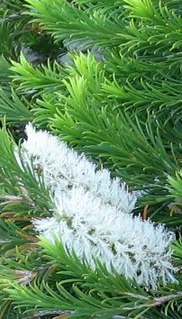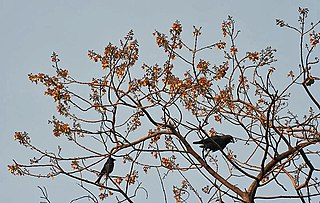
Melaleuca is a genus of nearly 300 species of plants in the myrtle family, Myrtaceae, commonly known as paperbarks, honey-myrtles or tea-trees. They range in size from small shrubs that rarely grow to more than 16 m (52 ft) high, to trees up to 35 m (115 ft). Their flowers generally occur in groups, forming a "head" or "spike" resembling a brush used for cleaning bottles, containing up to 80 individual flowers.

Eucalypt is a descriptive name for woody plants with capsule fruiting bodies belonging to seven closely related genera found across Australasia: Eucalyptus, Corymbia, Angophora, Stockwellia, Allosyncarpia, Eucalyptopsis and Arillastrum.

Canarium is a genus of about 100 species of tropical and subtropical trees, in the family Burseraceae. They grow naturally across tropical Africa, south and southeast Asia, Indochina, Malesia, Australia and western Pacific Islands; including from southern Nigeria east to Madagascar, Mauritius, Sri Lanka and India; from Burma, Malaysia and Thailand through the Malay Peninsula and Vietnam to south China, Taiwan and the Philippines; through Borneo, Indonesia, Timor and New Guinea, through to the Solomon Islands, Vanuatu, New Caledonia, Fiji, Samoa, Tonga and Palau.

Syzygium is a genus of flowering plants that belongs to the myrtle family, Myrtaceae. The genus comprises about 1200 species, and has a native range that extends from Africa and Madagascar through southern Asia east through the Pacific. Its highest levels of diversity occur from Malaysia to northeastern Australia, where many species are very poorly known and many more have not been described taxonomically.

Papuacedrus papuana is a species in the conifer family Cupressaceae, the sole species in the genus Papuacedrus. Some botanists do not consider this species as forming a distinct genus, but include it in the related genus Libocedrus. It is native to New Guinea and to the Indonesian Province of Maluku.

Backhousia is a genus of thirteen currently known species of flowering plants in the family Myrtaceae. All the currently known species are endemic to Australia in the rainforests and seasonally dry forests of Queensland, New South Wales and Western Australia.

Dysoxylum is a flowering plant genus of trees and shrubs from the mahogany family, Meliaceae.
Xanthomyrtus is a group of shrubs and trees in the botanical family Myrtaceae described as a genus in 1922. It is found in Borneo, Moluccas, Sulawesi, Philippines, New Guinea, Bismarck Archipelago and New Caledonia.

Asteromyrtus is a genus of flowering plants in the Myrtaceae family. It is closely related to Callistemon and Melaleuca.

The red-cheeked parrot is a species of parrot in the family Psittaculidae found in Indonesia, Papua New Guinea and the tip of northern Australia. There are 17 subspecies currently recognized. It is a stocky short-tailed parrot with predominantly green plumage. It exhibits sexual dimorphism; the adult male has red cheeks and a mauve nape and top of head, while the female is duller with a brown head.
Eucalyptopsis papuana is a species of plant in the family Myrtaceae. It is found in Maluku and New Guinea. It is threatened by habitat loss.

Gmelina is a genus of plants in the family Lamiaceae. It consists of about 35 species in Australia, New Guinea, New Caledonia, Southeast Asia, India and a few in Africa. Some species such as G. arborea have been planted and/or become naturalised in India, Africa and Australia. It was named by Carl Linnaeus in honour of botanist Johann Georg Gmelin.

Xanthostemon is a genus of trees and shrubs, constituting part of the myrtle plant family Myrtaceae. This genus was first described in 1857 by German–Australian botanist Ferdinand von Mueller. According to different official sources between 46 and 51 species are known to science. They grow naturally in New Caledonia, Australia, the Solomon Islands and Malesia, including the Philippines, New Guinea and Indonesia. The genera Pleurocalyptus and Purpureostemon from New Caledonia are morphologically close to Xanthostemon.

Phaleria is flowering plant genus of about 20-25 species in the family Thymelaeaceae.
Lyndley Alan Craven was a botanist who became the Principal Research Scientist of the Australian National Herbarium.
Corymbia papuana, commonly known as ghost gum, is a species of evergreen tree native to New Guinea, some Torres Strait Islands and the northern part of the Cape York Peninsula in Australia. It has smooth whitish bark, lance-shaped adult leaves, flower buds in groups of three or seven, creamy white flowers and barrel-shaped or urn-shaped fruit.
Stockwellia is a monotypic genus in the flowering plant family Myrtaceae. The sole species in the genus, Stockwellia quadrifida, is endemic to Queensland.

Aceratium is a genus of about 20 species of trees and shrubs of eastern Malesia and Australasia from the family Elaeocarpaceae. In Australia they are commonly known as carabeens. They grow naturally in rainforests, as large shrubs to understorey trees and large trees.
Lindsayomyrtus is a monotypic genus in the family Myrtaceae, containling the single species Lindsayomyrtus racemoides, commonly known as Daintree penda. These large trees grow naturally in the rainforests of the Wet Tropics of Queensland in Australia, the Moluccas, New Guinea and New Britain.
Octamyrtus is a group of plants in the myrtle family Myrtaceae described as a genus in 1922. It is native to New Guinea and to the nearby Indonesian Province of Maluku.
- Octamyrtus arfakensisKaneh. & Hatus. ex C.T.White - West New Guinea
- Octamyrtus behrmanniiDiels - New Guinea
- Octamyrtus glomerataKaneh. & Hatus. ex C.T.White - New Guinea
- Octamyrtus halmaherensisCraven & Sunarti - Halmahera
- Octamyrtus insignisDiels - New Guinea
- Octamyrtus pleiopetalaDiels - New Guinea, Aru Islands












